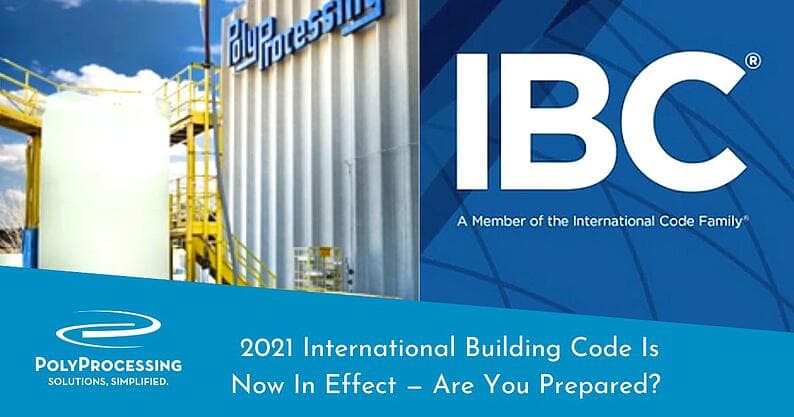2021 International Building Code Is Now In Effect — Are You Prepared?
Seismic codes govern structural design to prevent damage to buildings and structures during an earthquake. It’s common knowledge that buildings must conform to specific seismic codes, but your chemical storage tanks also have seismic regulations. Any facility in a seismically active region, including everywhere along the Pacific Rim, must pay careful attention to the safety measures established in the International Building Code.

The recent updates to the 2021 IBC have been adopted in California and will soon be adopted in all 50 states. The changes from the 2018 IBC to the 2021 IBC are fairly insignificant and will not change how we calculate for seismic restraints.
Storage Tanks and Self-supporting Structures
It can be confusing which parts of the code you need to be concerned with. As it pertains to storage tanks, the requirements in the ASCE in chapter 15 should be adhered to, and not chapter 13, which mentions vessels supported by a building. Essentially, the difference has to do with whether the tank is self-supporting or not.
To find the specific seismic code that relates to chemical storage tanks, refer to the 2018 IBC and the American Society of Civil Engineers (ASCE) 7-16, chapter 15.7, which covers “tanks and vessels that are supported within buildings.” This refers to any self-supporting structures that carry gravity loads and resist the forces of earthquakes or other seismic activity.
Poly Processing and Seismic Calculations
Poly Processing has built a calculation system to handle seismic code issues, whether you need a wet stamp, calculations for a permit, or data for budgeting and planning. Calculations are address-specific (now more than ever), so the end user’s address is necessary for us to provide you with the correct calculations.
Poly Processing has long-standing relationships with reliable third-party engineers that extend beyond 30 years. As a result, we can ensure that quality tank restraint systems are done correctly per state code. A qualified third-party engineer provides the design and certification stamps of all Poly Processing tanks requiring a certified seismic restraint system.
Even in areas of the United States with minimal seismic or wind activity, we typically see specifications for restraints. We’ve created restraint systems for almost every type of tank that we offer, whether it’s a vertical tank, IMFO (Integrally Molded Flanged Outlet) tank, sloped bottom tank, cone-bottom tank, SAFE-Tank double-walled tank system, or a tank in a secondary containment tank. Each seismic calculation is site-specific, so it’s important that you have a company working for you who is experienced in each region.
Proper seismic and wind restraints are a key component in operating a safe, long-lasting chemical storage system. The third-party engineer ensures that the design meets the current IBC requirements to give you peace of mind. The third-party engineer also backs the restraint system calculations and handles any questions with the IBC reviewer.
You can find our stock seismic drawings here.
Contact us to learn more about seismic restraints and our chemical storage tank systems.
- February 6, 2023
About Poly Processing
Posts By Topic
Tech Talk Podcast Episodes
Subscribe By Email
Recent Posts
- Installation Tips for Chemical Storage Tanks: Site Preparation and Offloading
- Understanding pH and Chemical Concentration When Choosing a Chemical Tank
- Maximizing Fill Efficiency: Selecting the Optimal Fill Line System
- Chemical Storage Tanks: A Quick Guide for End Users
- Popular Customization Options for Chemical Storage Tanks
Tank Configurator

Find the recommended tank and system components for your chemical storage challenge.
Configure a Tank Package


